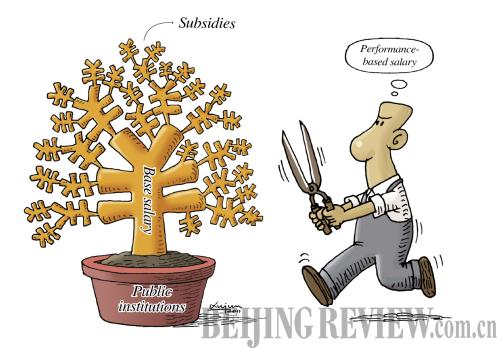|
 |
|
(CFP) |
On April 16, Xinhua News Agency released a set of draft guidelines outlining future reforms of public institutions for feedback about one year after a similar draft was circulated internally among China's central government departments. The reform is nothing less than an upheaval to China's public sector. The country has 1.26 million public institutions that employ around 30 million people and the reform roadmap promises changes to how public institutions manage and insure their employees, share profits, pay tax and the way they are structured.
Historically, China's public institutions included all public schools, universities, clinics, hospitals, libraries, performing groups, research institutes and media organizations. These were all fully or partly funded by the government. The personnel management of these quasi-government organizations used to be characterized by rigid and uniform pay scales.
The reform of China's public institutions can be traced back to a national conference in 1995, where pilot programs in several cities were announced. Over the following two decades, the Central Government has issued more guiding principles and conducted new pilot programs in various provinces. Although new personnel and pension management measures have been introduced to some public institutions, there has not been a universal national reform.
The development of public institutions lags far behind social development, many of these institutions have ambiguous functions, according to a circular that contains the guidelines from the Communist Party of China Central Committee and the State Council. "As a result, the provision of public services in China is insufficient and ineffective," it says.
In recent years, the public's complaints about public institutions have focused on those with administrative powers imposing unnecessary fines and fees to fund themselves, for-profit operation of public hospitals and schools, and outdated organization and management methods of public institutions, which result in the waste of public resources.
According to the circular, an efficient, clearly-defined and regulated mechanism for public institutions will be established by 2020.
The number of public institution employees is actually far greater than the number of civil servants in China and financing such a large number of institutions and people has become a major burden on the government.
According to the Ministry of Human Resources and Social Security, public institutions employ more than 20 million skilled professionals, a whopping 47.3 percent of all skilled professionals in China in 2010. The upcoming reform of public institutions will also affect 9 million retirees from these institutions, whose retirement benefits could be affected by changes in their former employers.
According to a Xinhua News Agency report on April 17, the essential goal of the reform is to offer better social services to the public instead of simply laying off workers, dismantling organizations and getting rid of financial burdens.
The core of the reform is the reclassification of all public institutions into three groups: Public institutions with administrative roles should be turned or merged into government departments; those that have business operations, such as publishing houses, will be gradually transformed into enterprises; and those providing social services will retain their status as public institutions.
The third group will be subdivided into two categories: Those providing basic public services, such as schools for compulsory education and research institutes engaged in fundamental sciences research, and those whose resources can partly be allocated by a free market, such as institutions of higher education. Institutions of the first category are entitled to full government funding while those of the second category are entitled to partial government funding as well as government support in the form of service purchases.
| 